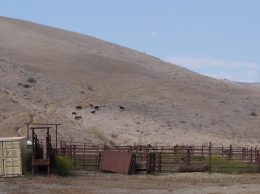Customers of the State Water Project will not receive any water deliveries this year if current dry conditions persist, a cutback that could be troublesome for certain tri-county cities.
The state Department of Water Resources announced Jan. 31 that no water would be allocated for 2014, but that a small amount of carryover from 2013 would be available to State Water Project service areas. Santa Barbara County is entitled to 45,486 acre-feet of state water each year. The full allotment for San Luis Obispo and Ventura counties is 25,000 and 20,000 acre-feet, respectively. But none will see a drop this year. One acre-foot of water can supply the needs of two families of four for one year.
The State Water Project, the nation’s largest state-built water conveyance system, supplies water for 25 million Californians and 750,000 acres of irrigated farmland.
“Although there’s a zero allocation, they still expect to see carryover water from previous years,” said Matt Naftaly, manger of the Santa Barbara County Water Agency. “So presumably there still will be water coming into the county from the State Water Project.”
But Ray Stokes, deputy director of the Central Coast Water Authority, a public agency that serves North Santa Barbara County, the Santa Ynez Valley and the South Coast, said the county’s carryover is only 30 percent of the total annual allotment. He said Solvang, Santa Barbara and Montecito will be particularly affected.
“I would say Montecito Water District is going to feel it most because they already don’t have enough water stored to meet their demand, so this will further exacerbate their issues,” Stokes told the Business Times. The city of Santa Barbara also is dependent on state water, which is pumped into Lake Cachuma.
“Historically [state water] has been used less because they had Cachuma, but with Cachuma at 40 percent, they’re using state water supplies to meet their demand in 2014,” Stokes said of Santa Barbara and Montecito.
He said Goleta and Carpinteria are better positioned because they have groundwater resources. The same is true for most of North Santa Barbara County, with the exception of Solvang. But those water supplies are also taking a hit amid the drought.
Water stores being depleted
Matt van der Linden, Solvang’s director of public works, said the city has relied on state water as its primary source for the last 12 years.
He said if the state allocation remains at zero and if the city is not able to buy supplemental water, it is likely that mandatory cutbacks will be instated.
Last month, the City Council implemented Stage One drought regulations, which include a voluntary 15 percent reduction in water use by all city customers.
In San Luis Obispo County, water districts are in the clear for now. “We will be able to meet our needs this year by using that stored water,” said Dean Benedix, manger of the county’s utilities division. However, the city of San Luis Obispo is using water from Whale Rock Reservoir near Cayucos to avoid pumping more groundwater. The reservoir is at 56 percent capacity and there will be trouble if there is no recharge, Benedix said.
Storage facilities are getting less and less water, reducing their ability to provide for the future, and groundwater is being more heavily pumped.
By the end of this year, most options will have been exhausted, he said. “2015 is going to be very, very bleak,” Benedix told the Business Times. “There are going to be serious, serious problems if we don’t get significant rainfall across the state.”
Ventura County water districts seem to have the situation under control. For the most part, agencies in the western part of the county do not rely on state water.
The United Water Conservation District is the only one in that area that has ever brought in state water, said Gerhardt Hubner, deputy director at the Ventura County Watershed Protection District.
The Ventura and Casitas water districts have never used their annual allotments. “The west side of the county is not relying on imported water,” he said. “The east side of the county is.”
Eric Bergh, resource manager at Calleguas Municipal Water District, said Thousand Oaks and Simi Valley are 100 percent dependent on state water. But thanks to ratepayer investment in storage, conservation and recycled water programs over the years, the district is in good shape. “They have created a drought buffer for us,” he told the Business Times.
Cities served by the Calleguas district that depend on a mix of state water and groundwater, such as Oxnard and Camarillo, may be in a tight spot.
With groundwater resources diminishing, those cities could become more reliant on state water supplies, Bergh said. In many places along the Oxnard Plain, groundwater has dipped below sea level.
Bergh noted that although Calleguas’ water supply is sufficient for this year, conservation measures must continue — even in wet years. “We are calling on folks to be mindful of their water use,” he said.






 Print
Print Email
Email
















